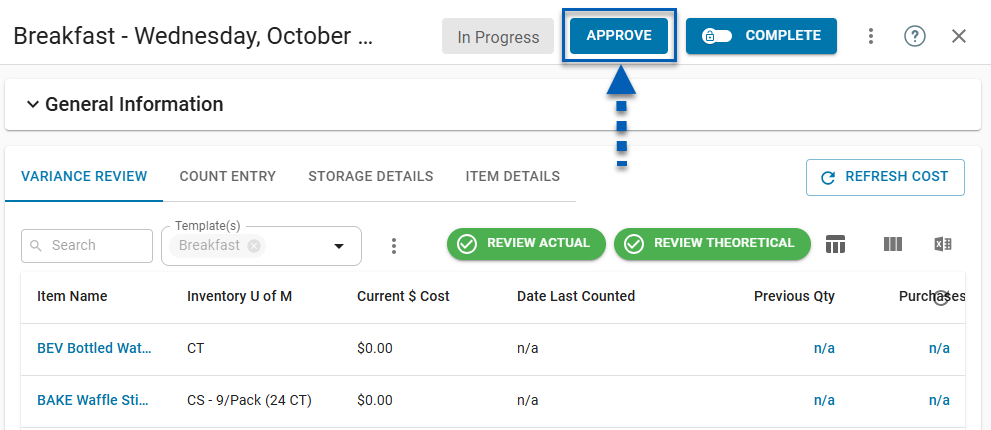This feature is in beta for select customers. Contact your CSM for more information.
After all quantities are entered, select Review to open the count in Review Mode. In this mode, users verify quantities, review variances, and resolve any alerts that appeared during entry.
Each alert highlights a difference between the current count and the previous one, helping users identify possible errors or missing data before the count is finalized. Counts can be edited directly in Review Mode to correct discrepancies and confirm accuracy.
The review process is an important step in maintaining reliable inventory data. Reviewing ensures that all items are counted correctly, cost variances are understood, and errors are caught early—before the count affects reporting or accounting.
Once all variances are addressed, the count can be completed to lock further edits. Users with approval permissions can then approve the count to finalize it for posting and reporting.
Important Note on Updating Inventory Count Templates
Before updating an inventory count template, ensure that all counts using that template are completed and/or approved. If a template is edited while it is in use, then it will be updated to reflect the structure of the In Progress count when that count is marked as completed and/or approved.
Security
Reviewing and approving inventory counts requires the following permissions:
Food
Inventory Counts
View Inventory Counts
View Inventory Counts
View Count Distribution Tab
View Variance Tab
Edit Inventory Counts
Edit Inventory Counts
Edit Items/Recipes
Add Items/Recipes
Remove Items/Recipes
Create Inventory Counts
Unlock Inventory Counts
This permission is only needed if a completed count needs to be unlocked to edit before approving.
Approve Inventory Counts
Review Mode
Inventory counts will need to be reviewed before marking the count as Approved. To initiate the review process, select the desired inventory count and then click Review from the Inventory Count header. This will reload the inventory count screen into Review Mode.
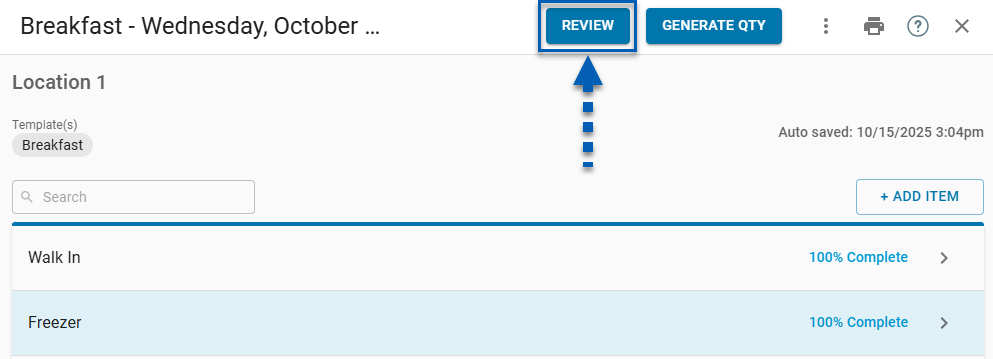
Review Inventory Count
When reviewing an Inventory Count, ensure to review the following areas to assist in resolving count issues:
1 | Review Actual/Theoretical Variances. Review any inventory count variances to quickly view and address count discrepancies
|
2 | Refresh Cost. If invoices are in progress at the time the count was started, ensure that all invoices are entered and approved and then click Refresh Cost in the inventory count review screen to update the costs. |
3 | Review Each Amounts. Sort the Unit of Measure 1 column from highest to lowest and then lowest to highest to find the items that have a higher or lower entry amount, respectively, than expected. Repeat this for each Unit of Measure column and compare these entry amounts alongside their UofMs listed to ensure that AP invoices have been entered correctly. |
4 | Filter the Review Tab for Alerts. Review the listed alerts to determine where potential errors were made. This could be an incorrectly entered amount or a skipped entry. |
5 | Add New Items. Ensure that any new items purchased for the first time since the last count have been added to this inventory count template. |
6 | Verify Proper Account Assignment. Navigate to the Distribution tab and review that the inventory count GL accounts match the cost GL accounts. If these do not match, open the Item Details tab and search for items that have been assigned to the same cost and inventory GL accounts.
|
7 | Compare Against the Balance Sheet. Run the balance sheet for the date and location of the inventory count and then click the Total value for inventory to view the GL account detail of those accounts. These balance sheet values should match the printed Count Review or Stock Count Quantity report where the beginning balance value should match the Previous Amt, the total value should match the End value, and the Adjustment should match the Adjustment, respectively. Reasons for a mismatch include:
|
8 | Optional: Run the Actual versus Theoretical Report. Run the AvT report to look for any variances that grew over the count cycle, or increased in amount without the explanation of purchases. These will be displayed in red in the Actual column and include items that were either counted incorrectly or an invoice or other transaction that is missing in the system. |
Editing Item Counts
If needed, item counts can be updated on both the Count Entry tab as well as the Item Details tab.
Once the Inventory Count has been completed, item counts can no longer be updated. To update item counts, the inventory count will need to be unlocked.
Count Entry tab
On the Count Entry tab, counts for the Item can be updated within a single storage location.
Click the current count for the desired UofM. This will open inline editing.
Update the count.
Press Enter or Tab on the keyboard or click anywhere on the sidesheet. Changes made are automatically saved.
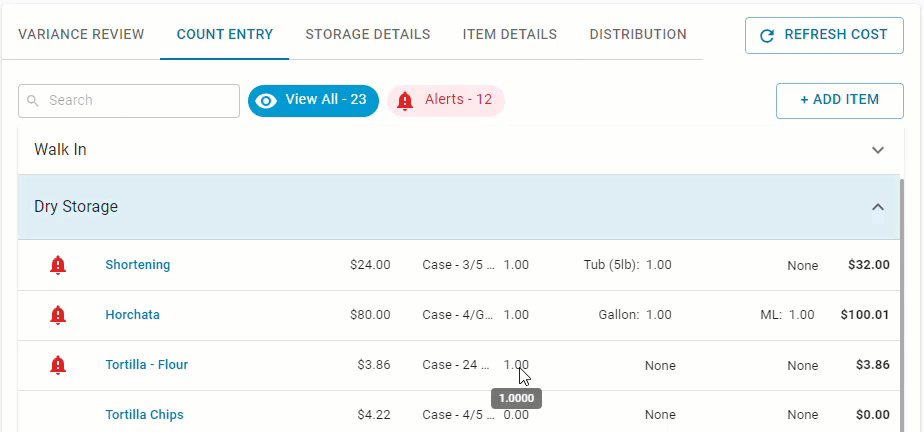
Item Details tab
On the Item Details tab, counts can be updated for the Item across all storage locations.
Click the line for the desired Item. This will open the storage location quantities form.
Click the count that needs to be updated.
Update the count.
Click DONE to close the form. Changes are automatically saved.
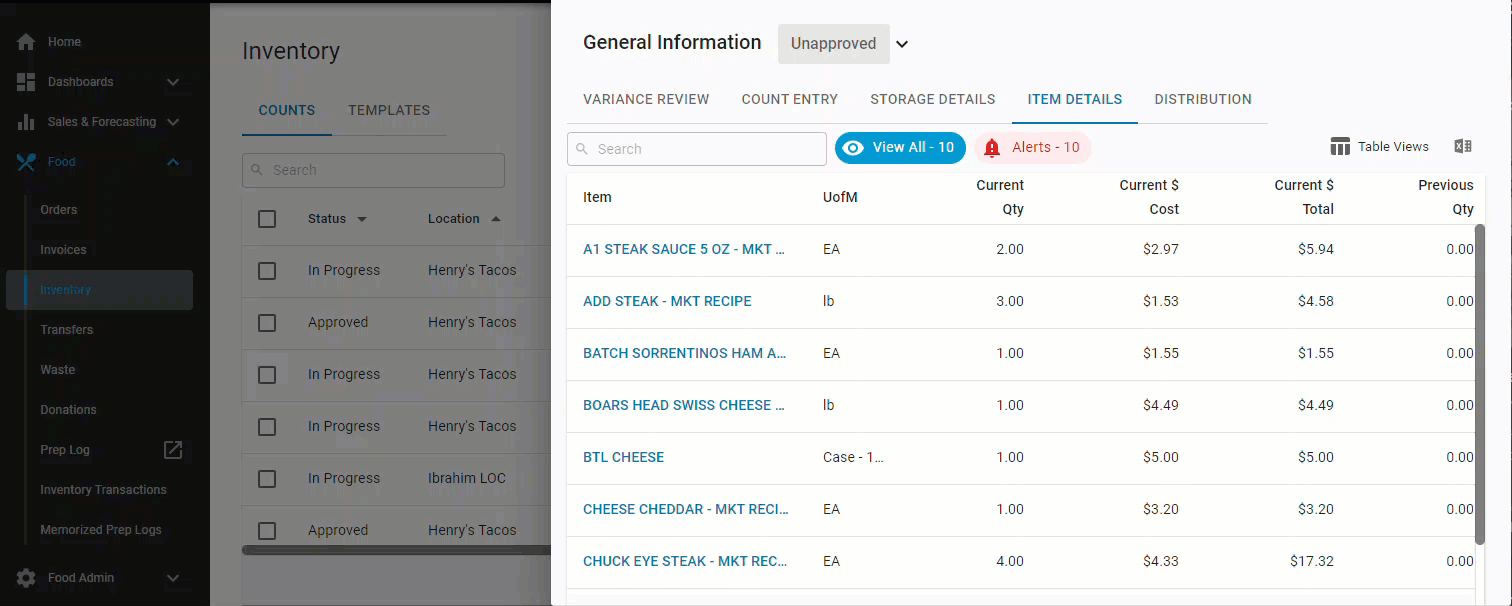
Users can also adjust the Item Details grid and save Table Views if necessary to view the Items Grid as desired.

Complete Inventory Count
Completing an inventory count will lock the count so that no other changes can be made. A complete count will signify that the count is ready for review before approval.
Counts do not have to be marked as complete in order to be marked as approved.
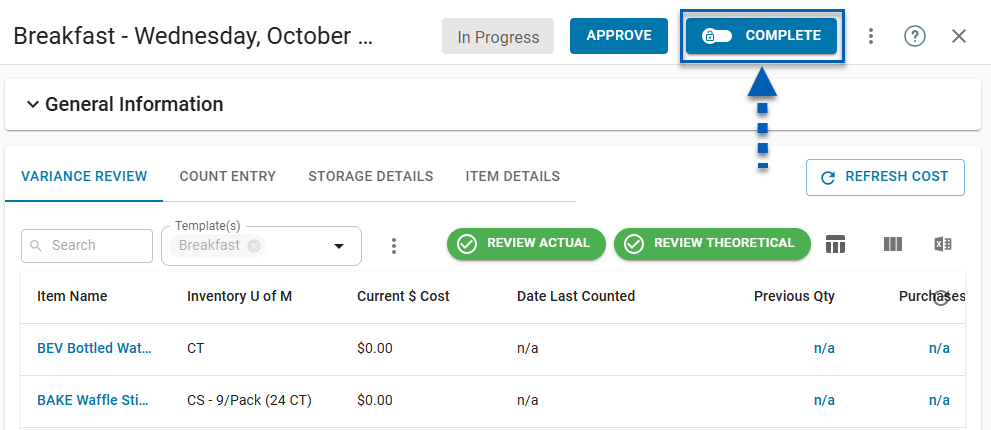
Approve Inventory Count
After reviewing all alert flags and updating the count where necessary, users with approval abilities can then approve the count by clicking the Approve button in the top right corner of the sidesheet. Approving a count finalizes the count. GL posting items will post to their GL account once the count has been approved, and item counts will be updated in the system where item counts are considered.
